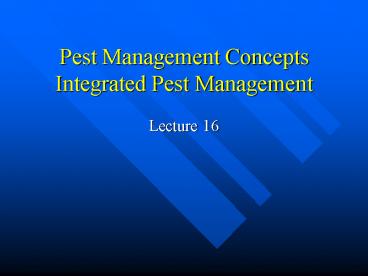Pest Management Concepts Integrated Pest Management - PowerPoint PPT Presentation
1 / 23
Title:
Pest Management Concepts Integrated Pest Management
Description:
Do Nothing. What pest have you identified? Is the pest really doing harm? ... pyrethroid insecticides are more toxic at lower temperatures ... – PowerPoint PPT presentation
Number of Views:897
Avg rating:3.0/5.0
Title: Pest Management Concepts Integrated Pest Management
1
Pest Management ConceptsIntegrated Pest
Management
- Lecture 16
2
IPM
Start of Intervention
EIL
ET
Population Size
Time
3
What is IPM?
- A holistic approach to pest management that
includes - multiple tactics used in a compatible manner
- pest populations maintained below levels that
cause economic damage - conservation of environmental quality (air,
water, soil, wildlife, and plant life)
4
IPM Strategy
- Identification of the problem
- Assessment of damage
- Cost-benefit analysis
- Selection of management tactic(s)
- Implementation of management tactic(s)
- Efficacy assessment
- Follow-up periodic assessment
5
Some Tactics of IPM
- Do nothing!
- Regulation
- Host resistance
- Biological control
- Use of pathogens
- Cultural techniques
- Physical and mechanical techniques
- Chemical modification of behavior
- Disruption of physiology
6
Do Nothing
- What pest have you identified?
- Is the pest really doing harm?
- How much damage can be sustained without economic
damage? - In a successful pest management program, only
monitoring for the resulting pest population may
be needed.
7
Regulatory Control
- Quarantines-limit movement of pests
- Eradication-must be applied to relatively small
geographic areas - Suppression-limit pest levels over large
geographic areas
8
Host Resistance
- Nonpreference-host characteristics that lead away
from the use of host for food - Antibiosis-deleterious effects on insect survival
resulting from feeding on a resistant host - Tolerance-ability of a host to support a pest
population that would be damaging to a
susceptible host
9
Biological Control
- Introduction of exotic natural enemies
- Conservation of natural enemies by careful use of
insecticides or manipulation of the environment - Augmentation of natural enemies to increase their
numbers
10
Pathogens
- Viruses- limited to cotton production (very
expensive to culture) - Bacteria- frequently applied for management of
lepidoptera (used in stored grain) - Fungi-require favorable conditions for
development of epizootics (not very specific) - Protozoa-has been used successfully for
grasshopper control on rangeland - Nematodes-promising for suppression of mosquito
populations
11
Cultural techniques
- Sanitation
- Stock rotation
- Modification of terrain (drain pools where
mosquitoes develop)
12
Physical and Mechanical Techniques
- Heat or cold storage
- Light traps
- Impact or impaction
13
Chemical Modification of Behavior
- Sex pheromones
- Aggregation Pheromones
- Oviposition deterring pheromones
- Alarm pheromones
- Trail pheromones
- Repellents
- Feeding deterrents
14
Chemical Disruption of Physiology
- Natural inorganic insecticides (sulfer)
- Natural organic insecticides (pyrethrum)
- Synthetic organic insecticides-most popular
insecticides (organophosphates) - Insect growth regulators (methoprene)
15
Integration of Techniques
- Aeration and biological control
16
Integration of Techniques
- Resistant packaging and removal of damaged
packages
17
Integration of Techniques
- Heat treatment and diatomaceous earth
18
Integration of Techniques
- Heat and pesticide application
- heat and double sticky tape
19
Integration of Techniques
- Attractant and insecticide (lure and kill)
- sex pheromone does not impact product
- reduces the amount of pesticide used
- may reduce need for fumigation
20
Integration of Techniques
- Traps and pathogens
- Insects are attracted to the trap with a
pheromone, but not captured - The insect contacts the pathogen
- The insect contacts others during mating and
transfers the pathogen
21
Integration of Techniques
- Vegetable oil and insecticide
- reduced by half the amount of pirimiphos-methyl
needed to kill 100 of granary weevils in stored
wheat
22
Integration of Techniques
- Insecticide and cooling
- pyrethroid insecticides are more toxic at lower
temperatures - lower temps limit pest population growth
23
The End Bugs Fight Back































